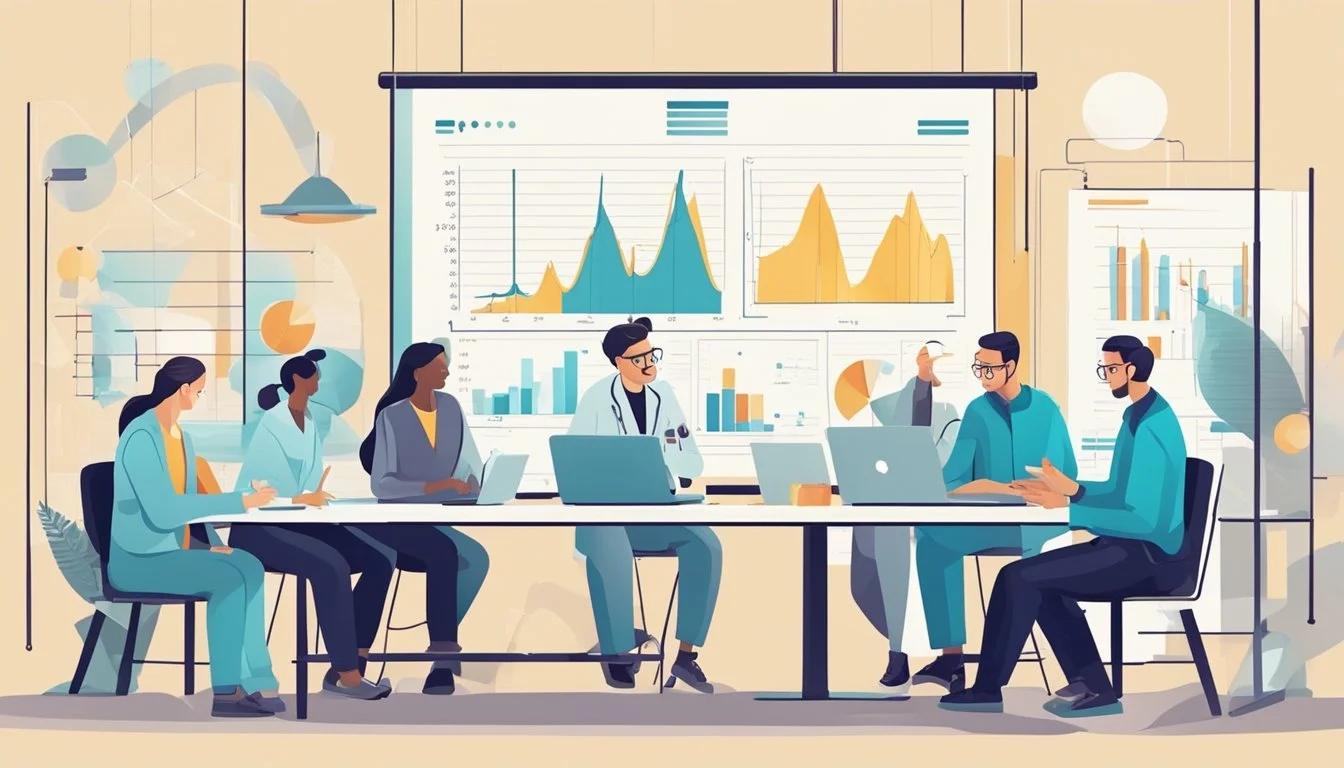Nate Silver: The Data Journalist Who Got It Wrong
A Cautionary Tale of Predictive Analytics
Nate Silver rose to prominence as a data journalist who sought to revolutionize political predictions through statistical analysis. His website FiveThirtyEight became a go-to source for election forecasts and polling interpretations. Silver's approach challenged traditional punditry and promised a more accurate, numbers-driven view of the political landscape.
Yet Silver's methods came under scrutiny after the 2016 U.S. presidential election. While his final forecast gave Donald Trump a higher chance of winning than many other analysts, the outcome still surprised many who relied on data-driven predictions. This event sparked debates about the limitations of polling and statistical models in capturing complex political realities.
Critics argue that Silver's emphasis on data sometimes overlooked important qualitative factors in elections. Some journalists contend that his approach led to overconfidence in quantitative analysis at the expense of on-the-ground reporting. The conversation around Silver's work raises important questions about the role of data journalism in modern media and the challenges of predicting human behavior through numbers alone.
Nate Silver: Profile of a Statistician
Nathaniel Read Silver rose to prominence as a statistician and data journalist, gaining fame for his innovative approaches to forecasting elections and analyzing sports statistics. His career trajectory spans from baseball analytics to political predictions, culminating in the creation of FiveThirtyEight.
Early Career and Entrance Into Politics
Nate Silver began his professional journey as a economic consultant at KPMG in Chicago. In 2003, he developed PECOTA, a system for forecasting Major League Baseball player performance. This work caught the attention of Baseball Prospectus, where Silver became a writer and partner.
Silver's transition to political analysis occurred in 2007 when he started posting on Daily Kos under the username "Poblano." His accurate predictions during the 2008 presidential primaries garnered widespread attention.
Transition From Baseball to Political Forecasting
Silver's success in baseball analytics laid the groundwork for his political forecasting methods. He applied statistical techniques used in sports to election prediction, creating models that aggregated and weighted polls.
In 2008, Silver correctly predicted the outcomes of 49 out of 50 states in the U.S. presidential election. This achievement catapulted him to national prominence as a political analyst.
His approach to political forecasting emphasized probability and uncertainty, distinguishing his work from traditional punditry.
Establishment of FiveThirtyEight
In March 2008, Silver launched FiveThirtyEight.com, named after the number of electors in the U.S. Electoral College. The site quickly gained popularity for its data-driven analysis of elections.
The New York Times licensed FiveThirtyEight in 2010, further expanding Silver's reach and influence. In 2013, ESPN acquired the website, with Walt Disney Company as its parent organization.
Under Silver's leadership, FiveThirtyEight expanded its coverage beyond politics to include sports, economics, and popular culture. The site became known for its use of data visualization and statistical analysis to explain complex topics.
The Science of Prediction
Prediction relies on analyzing data, understanding probabilities, and accounting for uncertainty. Polls, demographics, and statistical models form the foundation of modern forecasting techniques.
Understanding Polling Data
Polling data serves as a crucial input for election forecasts. Pollsters survey a sample of voters to gauge public opinion. They use random sampling methods to ensure representativeness.
Polls have margins of error that reflect statistical uncertainty. Larger sample sizes generally yield more precise results. Aggregating multiple polls can provide a clearer picture of voter sentiment.
Polling accuracy depends on factors like question wording and response rates. Undecided voters and last-minute shifts in opinion can impact final outcomes.
The Role of Demographics
Demographic information helps forecasters segment the electorate. Age, race, education, and income influence voting patterns.
Analysts use census data and past election results to model likely turnout among different groups. They examine how demographic changes might affect future elections.
Geographic distribution of voters matters too. Urban, suburban, and rural areas often show distinct voting preferences.
Weighing polls based on demographics can improve forecast accuracy. This helps account for potential under-sampling of certain groups.
Statistical Models and Probabilistic Forecasting
Statistical models combine polling data, demographics, and other factors to generate election forecasts. These models use historical patterns to inform predictions.
Forecasters like Nate Silver popularized probabilistic forecasts. Instead of a single outcome, they provide a range of possibilities with associated probabilities.
Models account for uncertainty through techniques like Monte Carlo simulations. This involves running thousands of scenarios to estimate likely outcomes.
Economic indicators, approval ratings, and fundraising data may also factor into models. Forecasters continuously refine their approaches based on new information and past performance.
The Track Record of Nate Silver
Nate Silver rose to prominence as a data journalist known for his election forecasts. His track record includes notable successes and some high-profile misses that sparked debate about the reliability of polling and statistical models in predicting elections.
Historical Election Predictions
Silver gained fame for accurately predicting the outcomes of the 2008 and 2012 U.S. presidential elections. In 2008, he correctly forecast the winner in 49 out of 50 states. His 2012 predictions were even more impressive, accurately calling all 50 states.
These successes established Silver as a leading voice in political forecasting. His methods, which combined polling data with demographic and economic factors, seemed to offer a more sophisticated approach to election prediction.
The Upsets and Controversies
The 2016 U.S. presidential election proved challenging for Silver and other forecasters. While his final forecast gave Donald Trump a higher chance of winning than many other models, it still favored Hillary Clinton.
This miscalculation led to criticism of Silver's methods and the broader field of data journalism. Some argued that forecasters had become overconfident in their ability to predict complex political events.
Silver's 2016 Republican primary predictions also faced scrutiny. He initially underestimated Trump's chances of securing the GOP nomination, adjusting his forecast as the primary season progressed.
Analysis of Silver's Forecast Accuracy
Studies of Silver's long-term accuracy show mixed results. His state-level predictions in presidential elections have been generally accurate, with success rates often exceeding 90%.
However, critics argue that Silver's models sometimes struggle with close races or unexpected political shifts. The 2016 election highlighted the challenges of accounting for polling errors and last-minute changes in voter sentiment.
Silver has acknowledged these limitations, emphasizing the importance of understanding uncertainty in forecasts. He continues to refine his methods, incorporating lessons learned from past elections to improve future predictions.
High-Profile Elections and FiveThirtyEight's Role
FiveThirtyEight's election forecasts gained prominence during several high-stakes presidential races. The site's predictions and analyses significantly influenced public perception and media coverage of these contests.
The 2016 Presidential Election
FiveThirtyEight's forecast for the 2016 election gave Hillary Clinton a 71.4% chance of winning. This prediction contrasted sharply with the actual outcome, where Donald Trump secured an Electoral College victory. The model underestimated Trump's support in key Midwest states like Wisconsin, Michigan, and Pennsylvania.
Factors contributing to the inaccuracy included:
Overreliance on national polls
Underestimation of undecided voters
Failure to account for late-breaking events, such as the James Comey letter
This miscalculation damaged FiveThirtyEight's reputation and sparked debates about the reliability of polling data and election forecasting methodologies.
2020 Election Analysis
For the 2020 presidential election, FiveThirtyEight adjusted its approach. The site gave Joe Biden an 89% chance of winning the Electoral College. While Biden did win, the race was closer than predicted in several swing states.
Key aspects of the 2020 forecast:
Increased emphasis on state-level polling
More conservative estimates of polling accuracy
Greater consideration of economic factors
Despite these improvements, FiveThirtyEight still faced criticism for underestimating Trump's performance in some areas.
Impact of Polling on Voter Perception
FiveThirtyEight's forecasts and analyses have significantly influenced how voters and media outlets perceive elections. The site's predictions often shape narratives about candidates' chances and campaign strategies.
Potential effects on voter behavior:
Increased turnout for perceived close races
Decreased motivation for supporters of predicted losers
Shifts in campaign resource allocation
Critics argue that widely publicized forecasts can create self-fulfilling prophecies or discourage voter participation. Supporters contend that data-driven analysis helps inform the electorate and promotes engagement in the democratic process.
Critiques and Defenses of Data Journalism
Data journalism has sparked intense debate within the media industry. Proponents tout its analytical rigor, while critics question its accuracy and value. This divide has led to scrutiny of data-driven methodologies and their place in modern reporting.
The Debate Over Data vs. Traditional Journalism
Data journalists rely on statistics and quantitative analysis to uncover stories and trends. Traditional journalists often emphasize on-the-ground reporting and expert interviews. This difference has created tension between the two approaches.
Skeptics argue that data journalism can oversimplify complex issues. They claim numbers alone cannot capture nuanced human experiences. Critics point to instances where data-driven predictions have been inaccurate, undermining public trust.
Supporters counter that data analysis adds depth to reporting. They assert it can reveal patterns invisible to traditional methods. Data journalists argue their work complements rather than replaces conventional reporting.
Challenges in the Data Journalism Field
Data journalism faces several hurdles in establishing credibility. Misinterpretation of statistics is a common pitfall. Journalists may draw faulty conclusions from incomplete or biased datasets.
The complexity of statistical methods can lead to errors. Even skilled data journalists may struggle with advanced analytical techniques. This can result in flawed reporting if not properly addressed.
Data quality remains a persistent issue. Journalists must navigate unreliable or inconsistent data sources. Verifying the accuracy of large datasets presents a significant challenge.
Defense of Data-Driven Methodology
Advocates of data journalism emphasize its potential for objective reporting. They argue that quantitative analysis can reduce bias in news coverage. Data-driven stories often provide concrete evidence to support claims.
Proponents highlight the ability of data journalism to uncover hidden trends. Large-scale data analysis can reveal patterns not apparent through anecdotal evidence. This approach has led to groundbreaking investigative reports.
Data journalists stress the importance of transparency in their work. Many publish their datasets and methodologies alongside articles. This openness allows for peer review and strengthens the credibility of their findings.
Implications for American Politics and Media
Nate Silver's data-driven approach reshaped political forecasting and campaign strategies. His methods influenced how candidates allocate resources and how voters engage with election information.
Influence on Political Campaigns
Campaigns now rely heavily on data analytics to guide decision-making. Strategists use polling data and statistical models to identify key voter demographics and tailor messages. This shift has led to more targeted outreach efforts and precise resource allocation.
Candidates focus on swing states and districts identified as crucial by data analysts. TV ad buys, rally locations, and volunteer efforts are often determined by polling numbers and statistical projections.
Data-driven campaigning has also changed fundraising tactics. Campaigns use predictive models to identify potential donors and customize appeals.
Voter Turnout and Engagement
Election forecasts can impact voter behavior. When polls predict a clear winner, some voters may feel their vote is less important and stay home. Conversely, close race predictions can motivate higher turnout.
Data journalism has increased voter interest in polling and statistics. Many voters now follow election forecasts regularly, treating them like sports standings.
This heightened engagement has both positive and negative effects. It can increase political awareness but may also lead to information overload or voter fatigue.
Role of Social Media
Social media platforms have become key channels for sharing election forecasts and polling data. Sites like Twitter allow forecasters to update predictions in real-time and engage directly with audiences.
These platforms can amplify the impact of poll results and forecasts, sometimes creating self-fulfilling prophecies. A viral tweet about a candidate's chances can quickly influence public perception.
Social media also enables the rapid spread of misinformation about polls and forecasts. False or misleading data can circulate widely before fact-checkers can respond.
Data journalists now must consider how their work will be shared and interpreted on social platforms, adding new complexities to their reporting.
Looking to the Future: The Evolving Landscape of Data Prediction
Data prediction continues to advance rapidly, transforming how we analyze elections and other complex events. New technologies and methodologies are emerging to improve forecasting accuracy and public understanding.
Advancements in Big Data and Analytics
Machine learning algorithms now process vast amounts of data to identify patterns and trends. Cloud computing enables faster analysis of complex datasets. Natural language processing extracts insights from social media and news articles.
These tools allow analysts to incorporate more diverse data sources into election forecasts. Satellite imagery, economic indicators, and demographic shifts can refine predictions. Real-time data streams provide up-to-the-minute information on voter sentiment and behavior.
Challenges remain in data quality and interpretation. Analysts must carefully weigh different factors and avoid overfitting models to past elections.
Upcoming Political Trends and Predictive Challenges
Polarization and the decline of swing voters make elections less predictable. Forecasters struggle to model the impact of misinformation and foreign interference.
Key questions for 2024 and beyond:
How will demographic changes affect electoral maps?
Can models account for new voting methods like widespread mail-in ballots?
What role will AI play in campaign strategies and voter outreach?
Analysts are developing techniques to gauge the views of undecided voters more accurately. They're also improving methods to account for systemic polling errors.
Educational Resources and Public Literacy in Statistics
Universities now offer more data science and political forecasting courses. Online platforms provide free statistics lessons to the public. News outlets are improving how they present probability and uncertainty in forecasts.
Resources for understanding election predictions:
FiveThirtyEight's "Statistics 101" series
The Princeton Election Consortium's educational tools
DataCamp's "Introduction to Political Data Analysis" course
Efforts aim to help voters interpret forecasts critically. Greater statistical literacy can reduce confusion about conflicting polls and projections.






